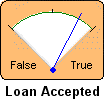
Meters are often the node form of choice for binary nodes like true/false propositions or okay/faulty conditions. Example:

Below the meter is the node’s name, title or both depending on the node’s labeling. The two states are printed at the bottom of the meter, on the left and right. The needle indicates the relative belief in each state. For the right-most state, the left end of the scale corresponds to a belief probability of 0% and the right end to 100%. The 50% point is when the needle is vertical, so the center of the scale is marked with a tick.
How To: Select any discrete nature node and choose Style → Meter. If no nodes are selected when you choose Style → Meter, the default style for the whole net will be set. If the needle has bands to the sides, or numbers appear instead of states (like this), it is because the node is continuous or has state numbers defined.
Finding: If a finding is entered, the background color of the node will be changed to gray (unless you've changed the default node colors). If it is a positive finding, the needle will be all the way to one side, indicating certainty.
Dimmed: If the current position of the needle is invalid for the findings entered (probably because the latest findings have not yet been taken into account with a belief updating), the needle will be drawn gray, or not at all.
More States: If the meter style is used for a node with more than two states, then all the states except the first will be grouped together and will be called “other”. The first state will be right-most on the meter, so its belief will be well represented by the needle (0% full left and 100% full right).
Continuous: For a continuous
variable example, click here.